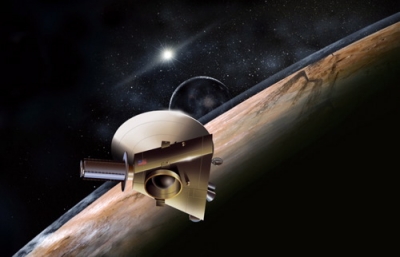Nine years to Pluto: NASA’s latest mission
GRS astronomer Paul Withers discusses the solar system's most mysterious planet

On January 19, NASA launched its $700 million unmanned New Horizons spacecraft from Florida’s Cape Canaveral on a nine-year, three-billion-mile journey to Pluto, the solar system’s smallest and most distant planet. Not much is known about Pluto, the only planet that has not been visited by an explorer spacecraft, and our best image of its surface is a hazy picture taken by the Hubble Space Telescope in 1996. The mission will also study the surrounding Kuiper Belt, which is made up of thousands of icy, rocky objects.
Pluto was discovered by astronomer Clyde Tombaugh in 1930. Named after the Roman god of the underworld, the planet is thought to have no atmosphere and is believed to be covered with ice. Some astronomers even dispute Pluto’s right to be called a planet, arguing that it is more accurate to describe the heavenly body as a comet or an asteroid.
Paul Withers, a research associate at the GRS Center for Space Physics, addressed the debate on Pluto’s status as a planet in a September issue of Eos. An expert in planetary science, Withers was a member of NASA’s Spirit Atmospheric Advisory Team, which analyzed the upper regions of the Martian atmosphere based on data collected by the Spirit space rover in 2004. He talked with BU Today about what NASA hopes to learn from its mission to Pluto.
BU Today: What new information is expected from this mission?
Paul Withers: Lots. We don’t know whether Pluto has any impact craters, geysers, or mountains. Photos by New Horizons will reveal whether it does or not, which will help scientists explain how Pluto formed 4.5 billion years ago, how it has changed since then, and how it will change in the future. New Horizons will study Pluto’s atmosphere and determine whether it is escaping into space and how it is related to the ice on Pluto’s surface.
This is just a flyby mission. Wouldn’t we learn more about the planet if the probe were to land and collect samples?
The probe will do more than just take pictures. An infrared spectrometer will measure the chemical composition of the surface. An ultraviolet spectrometer will measure the chemical composition of the atmosphere. A couple of instruments will measure ions and atoms that have escaped from Pluto and will be drifting by New Horizons. Landing would be great, but it would also be difficult and expensive. Space exploration has tended to follow a three-step program: flyby, orbit, land. First, send a spacecraft to fly past a planet without stopping. Second, put a spacecraft in orbit around the planet. Third, land on the planet. The first step provides an overview of what the planet is like. Its results help develop plans for the second step. The second step provides a good global map of the characteristics of the planet. Its results help develop plans for the third step, which gives unprecedented detail about a small region of the planet. Interpreting the results from a lander requires the global context provided by the results of previous flyby and orbiter missions. This is how the moon, Mars, and Venus were explored at the start of the space age, and how Jupiter and Saturn are being explored today. Pluto and the Kuiper Belt really are a new horizon for solar system exploration, both in terms of the scientific questions and the technology needed to answer them. If the flyby seems less sophisticated than Mars Rovers or Cassini at Saturn, that is because NASA’s reaching further out into the solar system.
According to NASA, the probe will collect data from the Kuiper Belt because it could hold clues to how the planets were formed. What will scientists be looking for in this respect?
The solid bodies in the solar system — rocky planets like Earth and the cores of gas planets like Jupiter — were formed from lots of smaller solid bodies that over time bumped into each other and stuck together. Understanding what these smaller building blocks were like will answer lots of big questions concerning the formation of the solar system. In the inner solar system, those building blocks have been totally altered, either by heat and pressure within a large planet such as Earth or just by the heat of the sun on a smaller body like an asteroid. In the outer solar system, some of these building blocks — Kuiper Belt objects — have remained unaltered for billions of years. They’ve never been close enough to the sun to be chemically altered by its heat, and they’ve never been altered by being part of a larger planet.